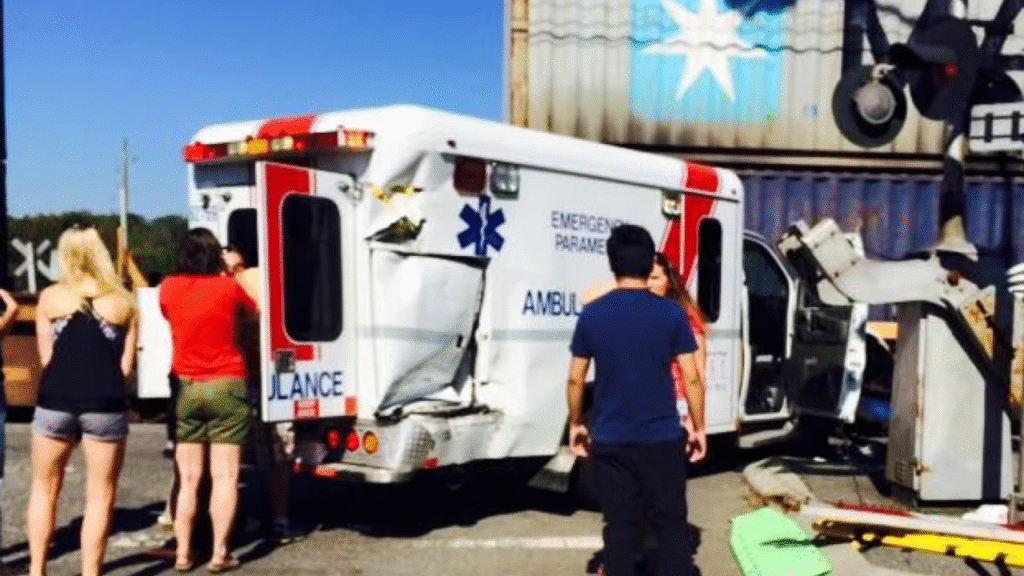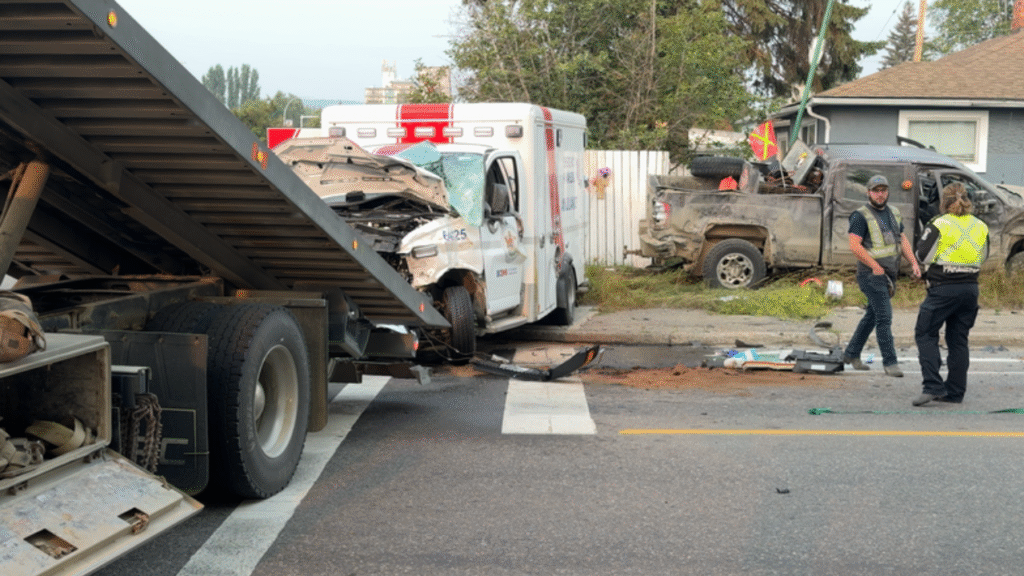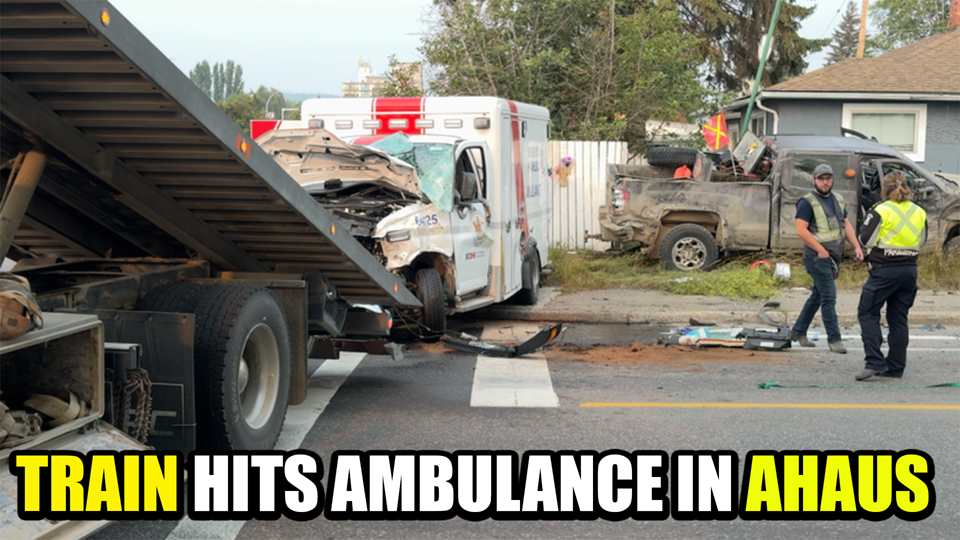On a tragic afternoon in the German town of Ahaus, an emergency turned into catastrophe. A train rammed an ambulance that had come to a stop on railway tracks, leading to the death of an 88-year-old patient being transported inside. Paramedics on board managed to escape just in time, but the loss of the patient and the violent nature of the crash left the community in shock. The incident, now under investigation, raises urgent questions about safety at railway crossings and emergency response protocols.
The train rams ambulance in Ahaus tragedy is more than just a headline—it is a reminder of how a split-second decision, combined with infrastructure risks, can alter lives forever.

The Incident: What Happened in Ahaus?
The crash occurred when paramedics were transporting an elderly patient across a railway crossing. For reasons still under investigation, the ambulance became stranded on the tracks. Within moments, a train barreled through, colliding with the vehicle at high speed.
The force of the collision destroyed the ambulance beyond recognition. Eyewitnesses described a terrifying scene of debris scattered across the tracks. The paramedics, who narrowly escaped, could only watch as the train carried the crushed vehicle several meters before halting.
Sadly, the 88-year-old patient did not survive. Authorities confirmed that the patient was unable to be evacuated in time.
Paramedics: Survival Against All Odds
Emergency responders dedicate their lives to saving others, yet in Ahaus, they found themselves fighting for survival. Reports suggest that the paramedics were able to act quickly, opening the doors and jumping out of the ambulance just before impact.
Although physically unharmed, the psychological toll is immeasurable. Surviving while a patient under their care perished is a trauma that will haunt them for years.
Ahaus: A Quiet Town Shaken
Ahaus, located near the Dutch border, is not typically in the headlines. Known for its calm atmosphere and cultural heritage, the town rarely sees such tragedy. Local residents expressed disbelief, with many questioning how such an accident could occur in a modern European country with advanced railway safety measures.
Candles and flowers were placed near the site of the collision, turning the spot into a place of mourning.
Investigating the Causes
Rail Infrastructure Challenges
Germany is renowned for its efficient train system, but even the best networks are not immune to risks. Level crossings, especially in rural areas, remain vulnerable points.
In the Ahaus accident, investigators are examining:
- Whether the warning signals functioned properly.
- If the ambulance driver had sufficient time to clear the tracks.
- The role of possible technical failures or human error.
Emergency Protocol Questions
Another key issue is how ambulances and other emergency vehicles should handle railway crossings. While urgency often dictates speed, caution is equally critical. Authorities are considering whether new guidelines are necessary to prevent future tragedies.
Safety Lessons from the Ahaus Train Crash
The train rams ambulance in Ahaus incident underlines critical safety lessons:
Always Expect a Train
Trains move faster than they appear. Even in rural areas with low frequency, one should assume a train could arrive at any moment.
Emergency Vehicles and Risk
Ambulances, police cars, and fire trucks must sometimes cross tracks under pressure. However, pausing, checking signals, and ensuring the path is clear remain vital steps.
Technology and Modernization
Investment in advanced barriers, automatic stop sensors, and real-time alerts could drastically reduce accidents at level crossings.
Real-Life Example: Similar Tragedies in Europe
This is not the first time a train has struck an emergency vehicle. In 2020, a similar incident in the Czech Republic involved a fire engine stuck on tracks, though fortunately without fatalities. In France, multiple cases of cars being trapped at crossings have prompted upgrades to barriers and warning systems.
Germany now faces the same reckoning—how to balance a world-class railway network with the safety of those who live near it.
Strategies for Preventing Future Incidents
Tips for Emergency Drivers
- Pause at crossings. Even with sirens on, never assume clearance.
- Check both directions. Visibility may be limited, especially at rural crossings.
- Know local train schedules. Emergency responders in small towns should familiarize themselves with frequent train times.
Infrastructure Improvements
- Installing smart sensors that stop trains when vehicles are detected on tracks.
- Increasing the number of overpasses or underpasses to replace risky level crossings.
- Providing paramedics with GPS-linked alerts about approaching trains.
Community Awareness
Educating communities about rail safety can help both drivers and pedestrians avoid tragic mistakes.
Human Toll: Beyond Statistics
When we read about accidents, numbers dominate headlines: one dead, two survived, dozens of passengers shaken. Yet behind each statistic lies a human story. The 88-year-old patient in Ahaus was more than a number; they were a person with a lifetime of memories, family, and dignity.
For the paramedics, their survival carries a heavy burden of grief. Their training tells them to save lives, but fate left them powerless.
FAQs About Train Rams Ambulance in Ahaus
Q1: What happened during the train rams ambulance in Ahaus incident?
A train struck an ambulance stranded on railway tracks in Ahaus, killing an 88-year-old patient while paramedics escaped.
Q2: How did the paramedics survive the Ahaus ambulance crash?
They acted quickly, exiting the ambulance just before the train impact.
Q3: Was the railway crossing in Ahaus faulty?
Investigators are still analyzing whether signals and barriers worked properly at the time.
Q4: Could the Ahaus train ambulance crash have been prevented?
Yes, improved technology, stricter emergency driving protocols, and better infrastructure could reduce risks.
Q5: What safety measures are being discussed after the Ahaus train crash?
Officials are considering advanced crossing sensors, stronger barriers, and new emergency service guidelines.

Conclusion
The train rams ambulance in Ahaus tragedy stands as a sobering reminder of how fragile safety can be. An 88-year-old patient lost their life in a situation where seconds mattered. While paramedics survived, their grief and trauma will endure.
Germany now faces a critical question: how to prevent such tragedies in the future. Improved infrastructure, modern technology, and stricter emergency driving protocols could save lives. Communities must honor the memory of the victim by learning from this heartbreaking event.
Every level crossing represents both a convenience and a risk. The Ahaus crash shows us why safety must always come first—because one mistake, one malfunction, or one moment of bad luck can cost a life.





